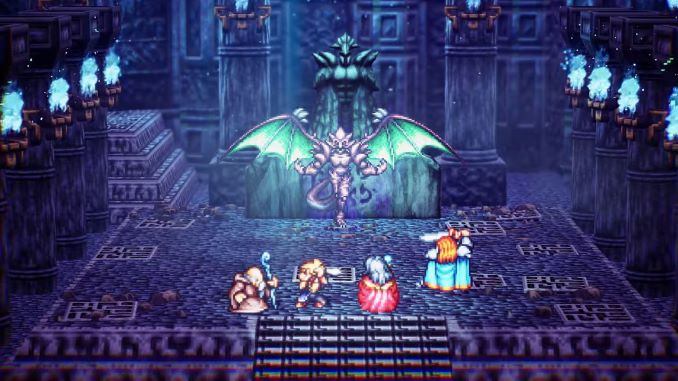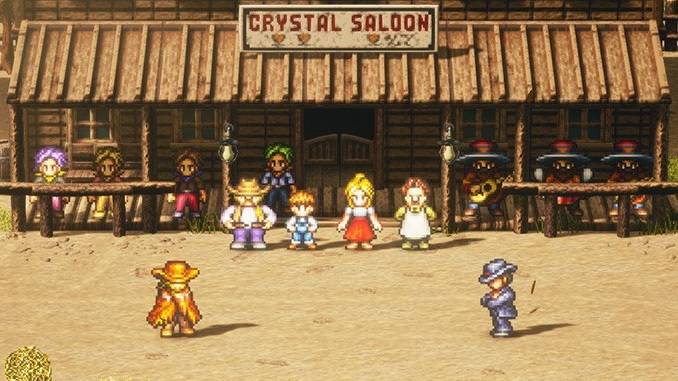Let’s get this out of the way: Live A Live is one of the best videogames ever made.
This is somewhat of a loaded and—more importantly—annoying statement. It’s the kind of lofty praise that gets applied to either beloved canon classics, such as the game’s direct successor Chrono Trigger, or rarities rendered inaccessible to a wide audience and spoken of as life changing by the chosen few that cross whatever technological or distributary boundaries to play it, such as this game’s nearest neighbor in culture, Mother 3. In either case, it imbues the game with an unfair burden, elevating it to mythical status, setting it up for failure when it’s ultimately just another videogame.
Live A Live is just a videogame. You can now buy it on your Nintendo Switch for $50. There is nothing about the game graphically or mechanically that will instantly thrill you in ways nothing ever has before. Yet this is not a weakness, it is core to Live A Live’s strengths. Instead of systemic complexity, Live A Live is laser focused on the potential of the RPG as an aesthetic experience, creating a joyful celebration of the genre and all its influences.
Core to this is the game’s anthologic structure, with disconnected chapters set across various time periods, each with their own distinct protagonist, genre and gameplay. One chapter is an RPG story told entirely without words, bringing out the best in the beautiful pantomime sprite animation that defined the genre until it leapt into 3D. Another chapter is just Street Fighter, complete with character select screen and win quotes. And yet another takes place in the Wild West, a distillation of the appeal of cowboy movies that uses the threat of an outlaw raid to turn the “searching through every house for random junk” part of RPGs into a genuinely thrilling cinematic climax.

This focus on genre pastiche over intricate worldbuilding makes Live A Live stand out from its peers arguably even more today than it did in the ‘90s. In a genre often criticized for storytelling that is simultaneously convoluted and generic, Live A Live embraces its simplicity and focuses all its efforts on the immediate emotional reaction of the characters, the events, and the sound. It doesn’t matter who Masaru is beyond being a fighting game protagonist who wants to be the best, when the boss declares he’s broken the warrior’s code and killed his opponents in pursuit of power and then “Megalomania” kicks in on the soundtrack it’s still the coolest thing that’s ever happened.
All of this was true when it was originally released in 1994, but perhaps most impressive about this new release is how it all remains true today, despite this new Live A Live being an entirely new game. The artwork in the new HD-2D style features entirely new spritework, which is as charming and expressive as in the original. The rearranged soundtrack is delightful and they even got Hironobu Kageyama to sing “Go! Go! Buriki Daioh.” The battle system has been tweaked to surface more elemental nuances and there’s even a few major story changes (uh oh!!) to the game’s ending. Any one of these elements could have been mishandled and tipped this project out of balance, leaving it as yet another Square Enix re-release that tarnishes what should be a golden legacy. Somehow, not only did that not happen, but the deftness of the additions makes this arguably the best version to recommend. Which leads to a conclusion that is as exciting as it is redundant: you can still make Live A Live today. They did make Live A Live today!
On one level this isn’t surprising. Live A Live is one of the influential pillars that leads directly into RPGMaker scenes on both sides of the pacific, from which springs an entire thriving subculture of independent RPGs that while tonally incredibly divergent are united in a similar focus on the potential of the RPG as an aesthetic storytelling form. From Yume Nikki all the way through to Omori, this is a space that has only grown exponentially in the time between these two releases.
On another level this is huge. Square Enix themselves have moved further and further away from Live A Live’s design values. You need to look no further than the superficially similar HD-2D anthology Octopath Traveler to see the focus on systemic design and complex battle mechanics that define so much of Square Enix’s modern RPGs. In many ways, Live A Live (2022)’s closest relative is Dungeon Encounters, a dungeon crawler light on both story and graphics that, while as far from Live A Live as possible in concept, is another example of a legendary Square staff member from the ‘90s proving that even if the in-fashion trends have left them behind, when they are allowed to step up to the mat, they still got it.
Live A Live still has it. Takashi Tokita led a young team of fans at Historia, Inc. to create a version of a classic as vibrant and exciting and crucially unique in Square’s catalog today as it was in 1994. Released between Final Fantasy VI and Chrono Trigger and passed over for translation due to its technically less impressive sprite work compared to its flagship siblings, it shines today as the celebration of a cult classic, with a worldwide legacy and influence as an important milestone in an entire alternate history of RPGs. Live A Live is the exact opposite of the unique masterpiece that’s so good it ruins other games: it is a heartfelt tribute to everything there is to love about the RPG format, and will leave you invigorated and excited not just to play more RPGs, but to watch more Kung Fu movies, more Westerns, more classic Sci-Fi. If you’ve even a passing interest in the genre, it is simply a must play.
Also, Toby Fox is right. “Megalomania” really does go that hard.
Live A Live was developed by Square Enix and Historia and published by Nintendo. It is available for the Switch.
Jackson Tyler is an nb critic and podcaster at Abnormal Mapping. They’re always tweeting at @headfallsoff.

